Professional Misconduct in Nursing: A Case Study from Australia
VerifiedAdded on 2022/11/01
|6
|1987
|3
Report
AI Summary
This report presents a case study of professional misconduct in Australian nursing, specifically addressing medication forgery and prescription theft by a nurse, Ms. Morey. It examines the violation of professional accountability, nursing practice standards, and the Australian National Law. The report highlights the significance of collegial accountability, emphasizing the role of colleagues in identifying and reporting misconduct. It further explores organizational responses to professional misconduct, including the need for internal inquiries, mental status assessments, and root cause analysis. The analysis underscores the importance of safe governance, staff management, and the overall impact of misconduct on patient care and healthcare outcomes. The report references various scholarly sources to support its findings and recommendations.
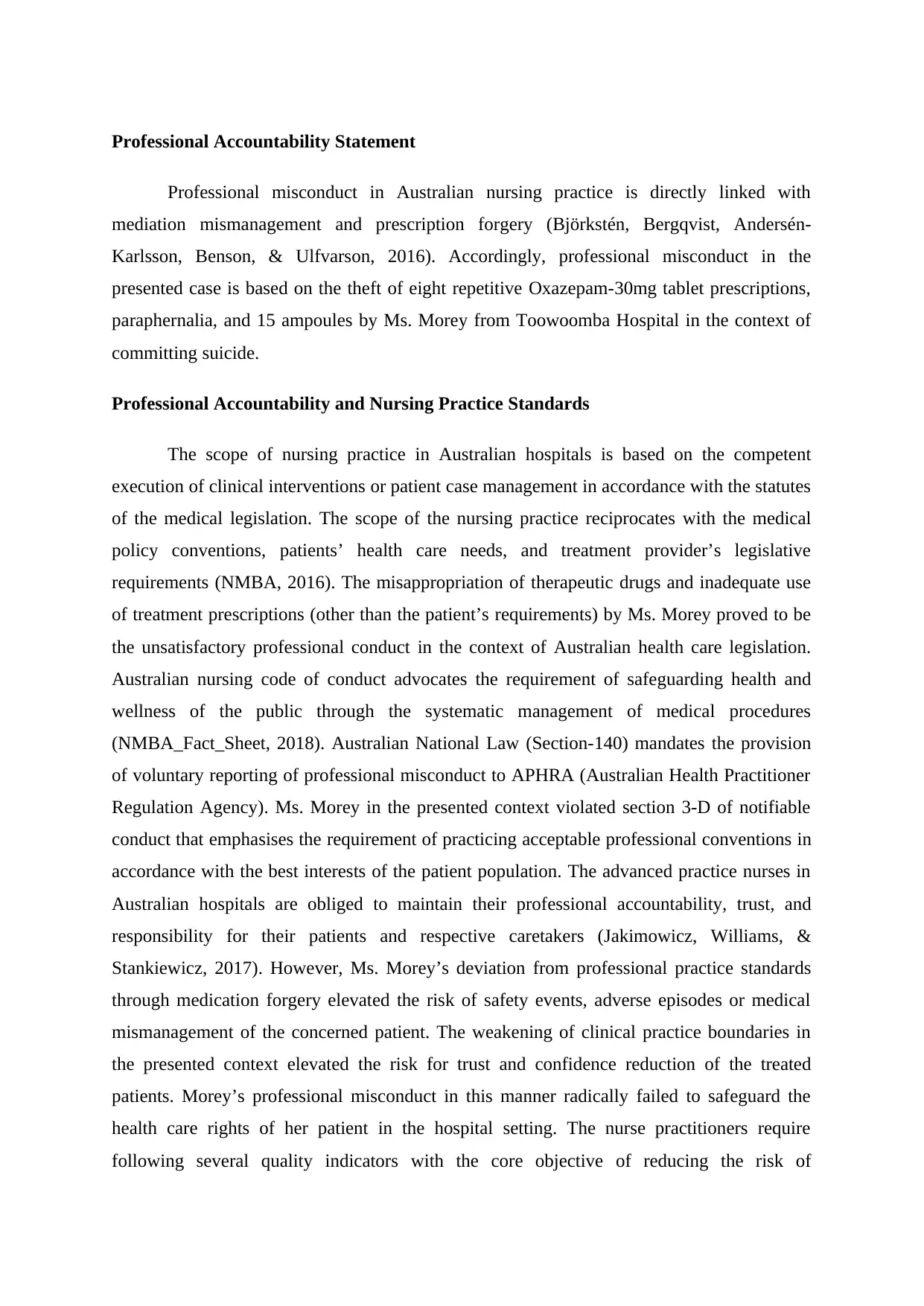
Professional Accountability Statement
Professional misconduct in Australian nursing practice is directly linked with
mediation mismanagement and prescription forgery (Björkstén, Bergqvist, Andersén-
Karlsson, Benson, & Ulfvarson, 2016). Accordingly, professional misconduct in the
presented case is based on the theft of eight repetitive Oxazepam-30mg tablet prescriptions,
paraphernalia, and 15 ampoules by Ms. Morey from Toowoomba Hospital in the context of
committing suicide.
Professional Accountability and Nursing Practice Standards
The scope of nursing practice in Australian hospitals is based on the competent
execution of clinical interventions or patient case management in accordance with the statutes
of the medical legislation. The scope of the nursing practice reciprocates with the medical
policy conventions, patients’ health care needs, and treatment provider’s legislative
requirements (NMBA, 2016). The misappropriation of therapeutic drugs and inadequate use
of treatment prescriptions (other than the patient’s requirements) by Ms. Morey proved to be
the unsatisfactory professional conduct in the context of Australian health care legislation.
Australian nursing code of conduct advocates the requirement of safeguarding health and
wellness of the public through the systematic management of medical procedures
(NMBA_Fact_Sheet, 2018). Australian National Law (Section-140) mandates the provision
of voluntary reporting of professional misconduct to APHRA (Australian Health Practitioner
Regulation Agency). Ms. Morey in the presented context violated section 3-D of notifiable
conduct that emphasises the requirement of practicing acceptable professional conventions in
accordance with the best interests of the patient population. The advanced practice nurses in
Australian hospitals are obliged to maintain their professional accountability, trust, and
responsibility for their patients and respective caretakers (Jakimowicz, Williams, &
Stankiewicz, 2017). However, Ms. Morey’s deviation from professional practice standards
through medication forgery elevated the risk of safety events, adverse episodes or medical
mismanagement of the concerned patient. The weakening of clinical practice boundaries in
the presented context elevated the risk for trust and confidence reduction of the treated
patients. Morey’s professional misconduct in this manner radically failed to safeguard the
health care rights of her patient in the hospital setting. The nurse practitioners require
following several quality indicators with the core objective of reducing the risk of
Professional misconduct in Australian nursing practice is directly linked with
mediation mismanagement and prescription forgery (Björkstén, Bergqvist, Andersén-
Karlsson, Benson, & Ulfvarson, 2016). Accordingly, professional misconduct in the
presented case is based on the theft of eight repetitive Oxazepam-30mg tablet prescriptions,
paraphernalia, and 15 ampoules by Ms. Morey from Toowoomba Hospital in the context of
committing suicide.
Professional Accountability and Nursing Practice Standards
The scope of nursing practice in Australian hospitals is based on the competent
execution of clinical interventions or patient case management in accordance with the statutes
of the medical legislation. The scope of the nursing practice reciprocates with the medical
policy conventions, patients’ health care needs, and treatment provider’s legislative
requirements (NMBA, 2016). The misappropriation of therapeutic drugs and inadequate use
of treatment prescriptions (other than the patient’s requirements) by Ms. Morey proved to be
the unsatisfactory professional conduct in the context of Australian health care legislation.
Australian nursing code of conduct advocates the requirement of safeguarding health and
wellness of the public through the systematic management of medical procedures
(NMBA_Fact_Sheet, 2018). Australian National Law (Section-140) mandates the provision
of voluntary reporting of professional misconduct to APHRA (Australian Health Practitioner
Regulation Agency). Ms. Morey in the presented context violated section 3-D of notifiable
conduct that emphasises the requirement of practicing acceptable professional conventions in
accordance with the best interests of the patient population. The advanced practice nurses in
Australian hospitals are obliged to maintain their professional accountability, trust, and
responsibility for their patients and respective caretakers (Jakimowicz, Williams, &
Stankiewicz, 2017). However, Ms. Morey’s deviation from professional practice standards
through medication forgery elevated the risk of safety events, adverse episodes or medical
mismanagement of the concerned patient. The weakening of clinical practice boundaries in
the presented context elevated the risk for trust and confidence reduction of the treated
patients. Morey’s professional misconduct in this manner radically failed to safeguard the
health care rights of her patient in the hospital setting. The nurse practitioners require
following several quality indicators with the core objective of reducing the risk of
Secure Best Marks with AI Grader
Need help grading? Try our AI Grader for instant feedback on your assignments.
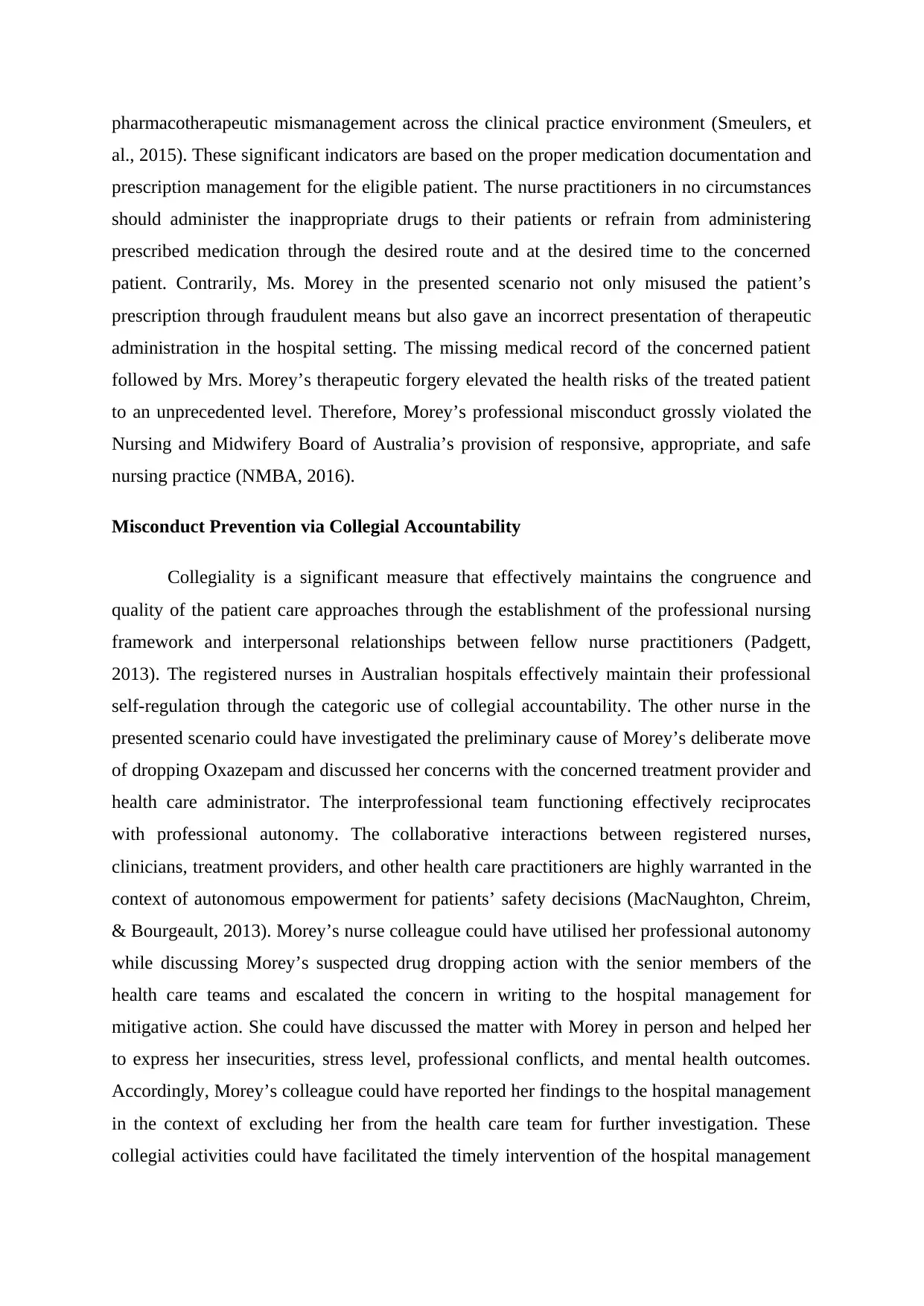
pharmacotherapeutic mismanagement across the clinical practice environment (Smeulers, et
al., 2015). These significant indicators are based on the proper medication documentation and
prescription management for the eligible patient. The nurse practitioners in no circumstances
should administer the inappropriate drugs to their patients or refrain from administering
prescribed medication through the desired route and at the desired time to the concerned
patient. Contrarily, Ms. Morey in the presented scenario not only misused the patient’s
prescription through fraudulent means but also gave an incorrect presentation of therapeutic
administration in the hospital setting. The missing medical record of the concerned patient
followed by Mrs. Morey’s therapeutic forgery elevated the health risks of the treated patient
to an unprecedented level. Therefore, Morey’s professional misconduct grossly violated the
Nursing and Midwifery Board of Australia’s provision of responsive, appropriate, and safe
nursing practice (NMBA, 2016).
Misconduct Prevention via Collegial Accountability
Collegiality is a significant measure that effectively maintains the congruence and
quality of the patient care approaches through the establishment of the professional nursing
framework and interpersonal relationships between fellow nurse practitioners (Padgett,
2013). The registered nurses in Australian hospitals effectively maintain their professional
self-regulation through the categoric use of collegial accountability. The other nurse in the
presented scenario could have investigated the preliminary cause of Morey’s deliberate move
of dropping Oxazepam and discussed her concerns with the concerned treatment provider and
health care administrator. The interprofessional team functioning effectively reciprocates
with professional autonomy. The collaborative interactions between registered nurses,
clinicians, treatment providers, and other health care practitioners are highly warranted in the
context of autonomous empowerment for patients’ safety decisions (MacNaughton, Chreim,
& Bourgeault, 2013). Morey’s nurse colleague could have utilised her professional autonomy
while discussing Morey’s suspected drug dropping action with the senior members of the
health care teams and escalated the concern in writing to the hospital management for
mitigative action. She could have discussed the matter with Morey in person and helped her
to express her insecurities, stress level, professional conflicts, and mental health outcomes.
Accordingly, Morey’s colleague could have reported her findings to the hospital management
in the context of excluding her from the health care team for further investigation. These
collegial activities could have facilitated the timely intervention of the hospital management
al., 2015). These significant indicators are based on the proper medication documentation and
prescription management for the eligible patient. The nurse practitioners in no circumstances
should administer the inappropriate drugs to their patients or refrain from administering
prescribed medication through the desired route and at the desired time to the concerned
patient. Contrarily, Ms. Morey in the presented scenario not only misused the patient’s
prescription through fraudulent means but also gave an incorrect presentation of therapeutic
administration in the hospital setting. The missing medical record of the concerned patient
followed by Mrs. Morey’s therapeutic forgery elevated the health risks of the treated patient
to an unprecedented level. Therefore, Morey’s professional misconduct grossly violated the
Nursing and Midwifery Board of Australia’s provision of responsive, appropriate, and safe
nursing practice (NMBA, 2016).
Misconduct Prevention via Collegial Accountability
Collegiality is a significant measure that effectively maintains the congruence and
quality of the patient care approaches through the establishment of the professional nursing
framework and interpersonal relationships between fellow nurse practitioners (Padgett,
2013). The registered nurses in Australian hospitals effectively maintain their professional
self-regulation through the categoric use of collegial accountability. The other nurse in the
presented scenario could have investigated the preliminary cause of Morey’s deliberate move
of dropping Oxazepam and discussed her concerns with the concerned treatment provider and
health care administrator. The interprofessional team functioning effectively reciprocates
with professional autonomy. The collaborative interactions between registered nurses,
clinicians, treatment providers, and other health care practitioners are highly warranted in the
context of autonomous empowerment for patients’ safety decisions (MacNaughton, Chreim,
& Bourgeault, 2013). Morey’s nurse colleague could have utilised her professional autonomy
while discussing Morey’s suspected drug dropping action with the senior members of the
health care teams and escalated the concern in writing to the hospital management for
mitigative action. She could have discussed the matter with Morey in person and helped her
to express her insecurities, stress level, professional conflicts, and mental health outcomes.
Accordingly, Morey’s colleague could have reported her findings to the hospital management
in the context of excluding her from the health care team for further investigation. These
collegial activities could have facilitated the timely intervention of the hospital management
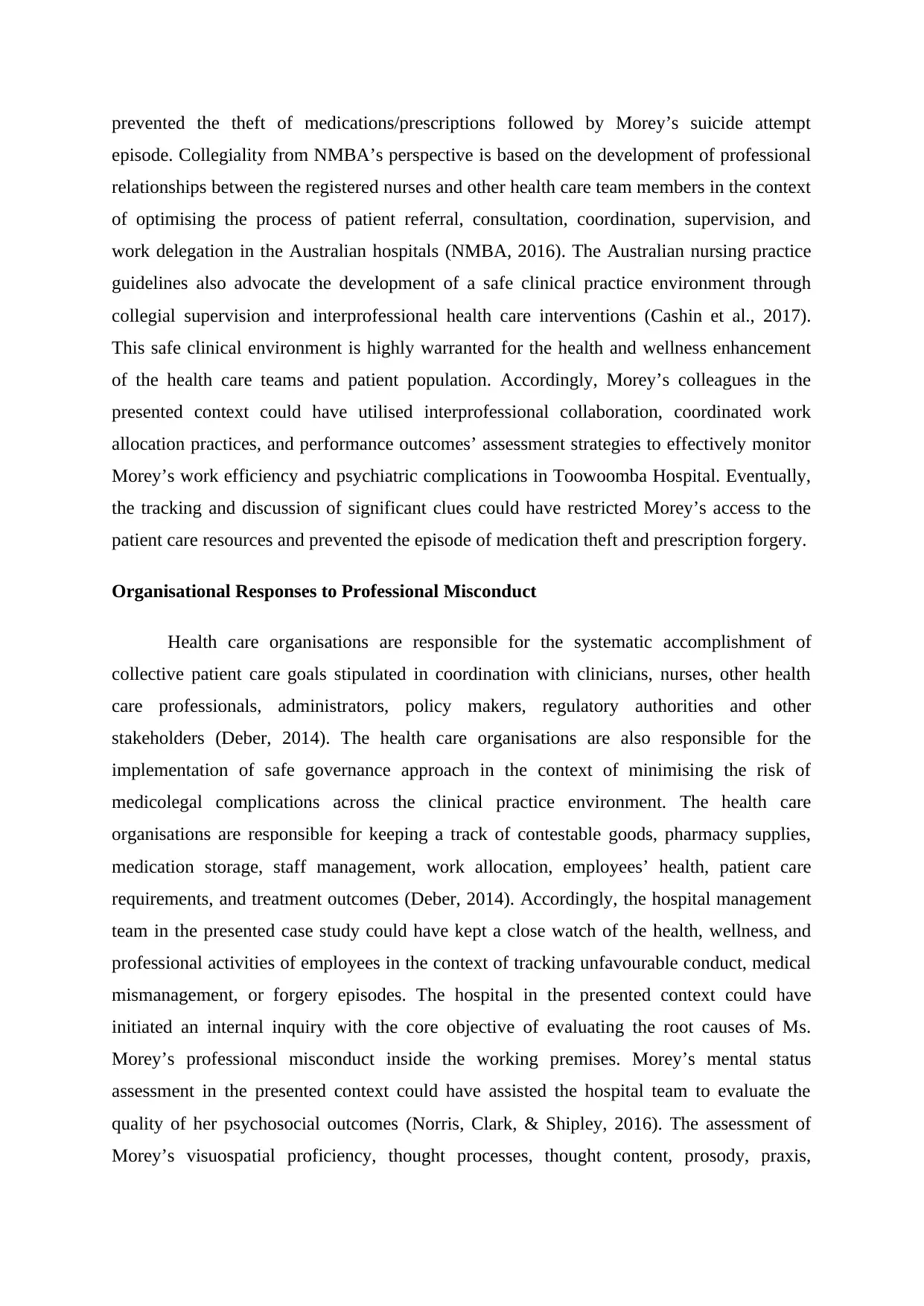
prevented the theft of medications/prescriptions followed by Morey’s suicide attempt
episode. Collegiality from NMBA’s perspective is based on the development of professional
relationships between the registered nurses and other health care team members in the context
of optimising the process of patient referral, consultation, coordination, supervision, and
work delegation in the Australian hospitals (NMBA, 2016). The Australian nursing practice
guidelines also advocate the development of a safe clinical practice environment through
collegial supervision and interprofessional health care interventions (Cashin et al., 2017).
This safe clinical environment is highly warranted for the health and wellness enhancement
of the health care teams and patient population. Accordingly, Morey’s colleagues in the
presented context could have utilised interprofessional collaboration, coordinated work
allocation practices, and performance outcomes’ assessment strategies to effectively monitor
Morey’s work efficiency and psychiatric complications in Toowoomba Hospital. Eventually,
the tracking and discussion of significant clues could have restricted Morey’s access to the
patient care resources and prevented the episode of medication theft and prescription forgery.
Organisational Responses to Professional Misconduct
Health care organisations are responsible for the systematic accomplishment of
collective patient care goals stipulated in coordination with clinicians, nurses, other health
care professionals, administrators, policy makers, regulatory authorities and other
stakeholders (Deber, 2014). The health care organisations are also responsible for the
implementation of safe governance approach in the context of minimising the risk of
medicolegal complications across the clinical practice environment. The health care
organisations are responsible for keeping a track of contestable goods, pharmacy supplies,
medication storage, staff management, work allocation, employees’ health, patient care
requirements, and treatment outcomes (Deber, 2014). Accordingly, the hospital management
team in the presented case study could have kept a close watch of the health, wellness, and
professional activities of employees in the context of tracking unfavourable conduct, medical
mismanagement, or forgery episodes. The hospital in the presented context could have
initiated an internal inquiry with the core objective of evaluating the root causes of Ms.
Morey’s professional misconduct inside the working premises. Morey’s mental status
assessment in the presented context could have assisted the hospital team to evaluate the
quality of her psychosocial outcomes (Norris, Clark, & Shipley, 2016). The assessment of
Morey’s visuospatial proficiency, thought processes, thought content, prosody, praxis,
episode. Collegiality from NMBA’s perspective is based on the development of professional
relationships between the registered nurses and other health care team members in the context
of optimising the process of patient referral, consultation, coordination, supervision, and
work delegation in the Australian hospitals (NMBA, 2016). The Australian nursing practice
guidelines also advocate the development of a safe clinical practice environment through
collegial supervision and interprofessional health care interventions (Cashin et al., 2017).
This safe clinical environment is highly warranted for the health and wellness enhancement
of the health care teams and patient population. Accordingly, Morey’s colleagues in the
presented context could have utilised interprofessional collaboration, coordinated work
allocation practices, and performance outcomes’ assessment strategies to effectively monitor
Morey’s work efficiency and psychiatric complications in Toowoomba Hospital. Eventually,
the tracking and discussion of significant clues could have restricted Morey’s access to the
patient care resources and prevented the episode of medication theft and prescription forgery.
Organisational Responses to Professional Misconduct
Health care organisations are responsible for the systematic accomplishment of
collective patient care goals stipulated in coordination with clinicians, nurses, other health
care professionals, administrators, policy makers, regulatory authorities and other
stakeholders (Deber, 2014). The health care organisations are also responsible for the
implementation of safe governance approach in the context of minimising the risk of
medicolegal complications across the clinical practice environment. The health care
organisations are responsible for keeping a track of contestable goods, pharmacy supplies,
medication storage, staff management, work allocation, employees’ health, patient care
requirements, and treatment outcomes (Deber, 2014). Accordingly, the hospital management
team in the presented case study could have kept a close watch of the health, wellness, and
professional activities of employees in the context of tracking unfavourable conduct, medical
mismanagement, or forgery episodes. The hospital in the presented context could have
initiated an internal inquiry with the core objective of evaluating the root causes of Ms.
Morey’s professional misconduct inside the working premises. Morey’s mental status
assessment in the presented context could have assisted the hospital team to evaluate the
quality of her psychosocial outcomes (Norris, Clark, & Shipley, 2016). The assessment of
Morey’s visuospatial proficiency, thought processes, thought content, prosody, praxis,
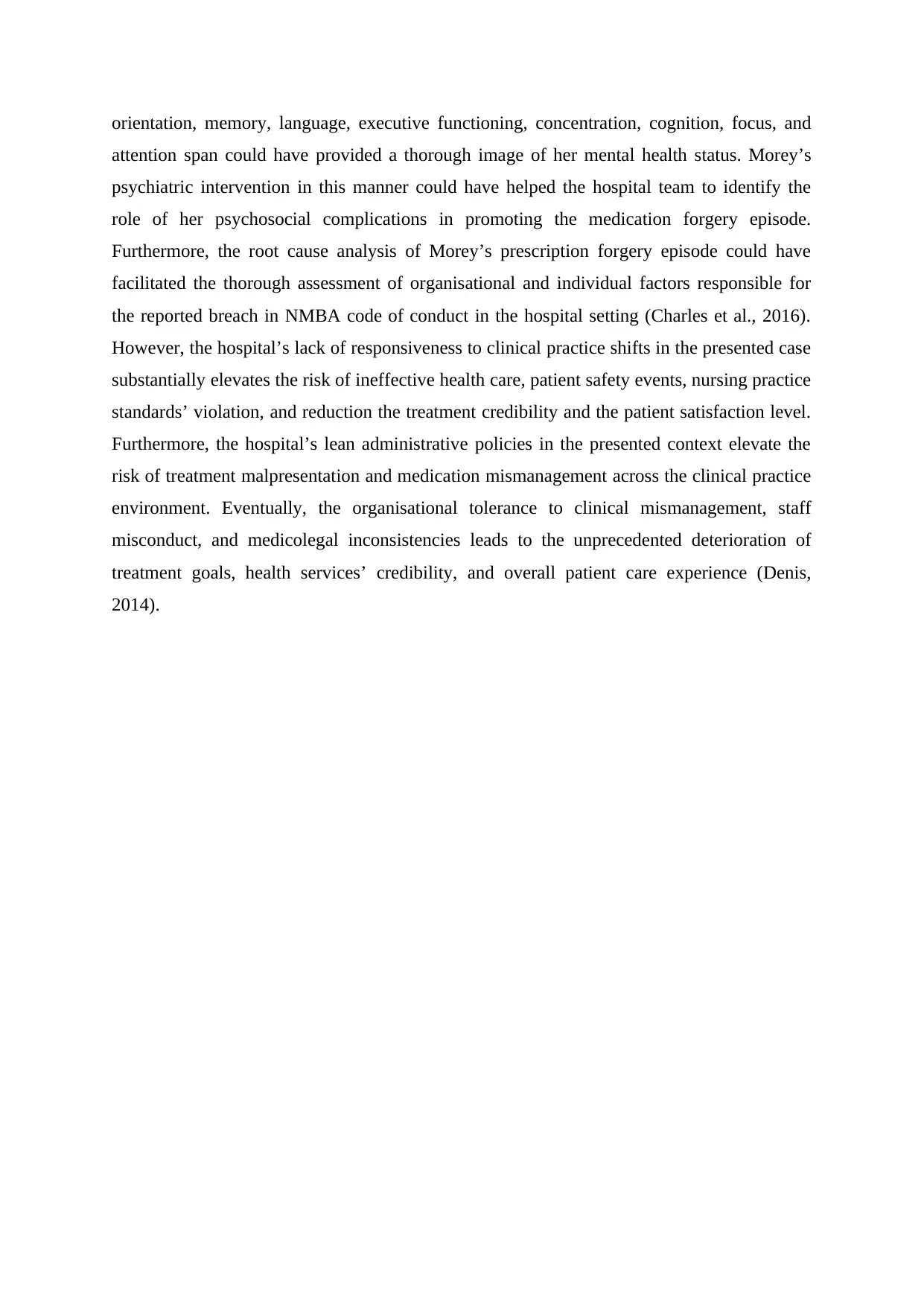
orientation, memory, language, executive functioning, concentration, cognition, focus, and
attention span could have provided a thorough image of her mental health status. Morey’s
psychiatric intervention in this manner could have helped the hospital team to identify the
role of her psychosocial complications in promoting the medication forgery episode.
Furthermore, the root cause analysis of Morey’s prescription forgery episode could have
facilitated the thorough assessment of organisational and individual factors responsible for
the reported breach in NMBA code of conduct in the hospital setting (Charles et al., 2016).
However, the hospital’s lack of responsiveness to clinical practice shifts in the presented case
substantially elevates the risk of ineffective health care, patient safety events, nursing practice
standards’ violation, and reduction the treatment credibility and the patient satisfaction level.
Furthermore, the hospital’s lean administrative policies in the presented context elevate the
risk of treatment malpresentation and medication mismanagement across the clinical practice
environment. Eventually, the organisational tolerance to clinical mismanagement, staff
misconduct, and medicolegal inconsistencies leads to the unprecedented deterioration of
treatment goals, health services’ credibility, and overall patient care experience (Denis,
2014).
attention span could have provided a thorough image of her mental health status. Morey’s
psychiatric intervention in this manner could have helped the hospital team to identify the
role of her psychosocial complications in promoting the medication forgery episode.
Furthermore, the root cause analysis of Morey’s prescription forgery episode could have
facilitated the thorough assessment of organisational and individual factors responsible for
the reported breach in NMBA code of conduct in the hospital setting (Charles et al., 2016).
However, the hospital’s lack of responsiveness to clinical practice shifts in the presented case
substantially elevates the risk of ineffective health care, patient safety events, nursing practice
standards’ violation, and reduction the treatment credibility and the patient satisfaction level.
Furthermore, the hospital’s lean administrative policies in the presented context elevate the
risk of treatment malpresentation and medication mismanagement across the clinical practice
environment. Eventually, the organisational tolerance to clinical mismanagement, staff
misconduct, and medicolegal inconsistencies leads to the unprecedented deterioration of
treatment goals, health services’ credibility, and overall patient care experience (Denis,
2014).
Secure Best Marks with AI Grader
Need help grading? Try our AI Grader for instant feedback on your assignments.
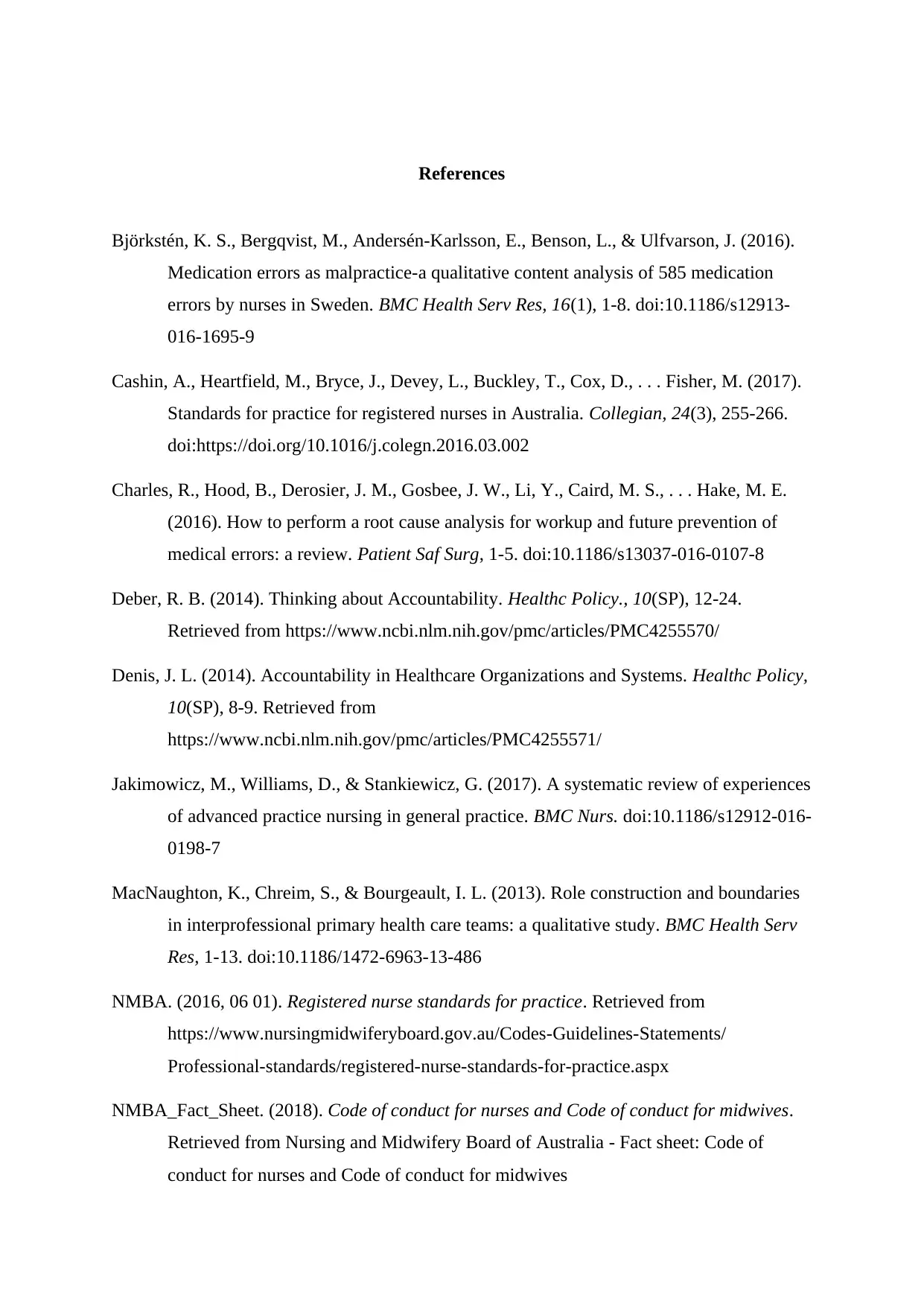
References
Björkstén, K. S., Bergqvist, M., Andersén-Karlsson, E., Benson, L., & Ulfvarson, J. (2016).
Medication errors as malpractice-a qualitative content analysis of 585 medication
errors by nurses in Sweden. BMC Health Serv Res, 16(1), 1-8. doi:10.1186/s12913-
016-1695-9
Cashin, A., Heartfield, M., Bryce, J., Devey, L., Buckley, T., Cox, D., . . . Fisher, M. (2017).
Standards for practice for registered nurses in Australia. Collegian, 24(3), 255-266.
doi:https://doi.org/10.1016/j.colegn.2016.03.002
Charles, R., Hood, B., Derosier, J. M., Gosbee, J. W., Li, Y., Caird, M. S., . . . Hake, M. E.
(2016). How to perform a root cause analysis for workup and future prevention of
medical errors: a review. Patient Saf Surg, 1-5. doi:10.1186/s13037-016-0107-8
Deber, R. B. (2014). Thinking about Accountability. Healthc Policy., 10(SP), 12-24.
Retrieved from https://www.ncbi.nlm.nih.gov/pmc/articles/PMC4255570/
Denis, J. L. (2014). Accountability in Healthcare Organizations and Systems. Healthc Policy,
10(SP), 8-9. Retrieved from
https://www.ncbi.nlm.nih.gov/pmc/articles/PMC4255571/
Jakimowicz, M., Williams, D., & Stankiewicz, G. (2017). A systematic review of experiences
of advanced practice nursing in general practice. BMC Nurs. doi:10.1186/s12912-016-
0198-7
MacNaughton, K., Chreim, S., & Bourgeault, I. L. (2013). Role construction and boundaries
in interprofessional primary health care teams: a qualitative study. BMC Health Serv
Res, 1-13. doi:10.1186/1472-6963-13-486
NMBA. (2016, 06 01). Registered nurse standards for practice. Retrieved from
https://www.nursingmidwiferyboard.gov.au/Codes-Guidelines-Statements/
Professional-standards/registered-nurse-standards-for-practice.aspx
NMBA_Fact_Sheet. (2018). Code of conduct for nurses and Code of conduct for midwives.
Retrieved from Nursing and Midwifery Board of Australia - Fact sheet: Code of
conduct for nurses and Code of conduct for midwives
Björkstén, K. S., Bergqvist, M., Andersén-Karlsson, E., Benson, L., & Ulfvarson, J. (2016).
Medication errors as malpractice-a qualitative content analysis of 585 medication
errors by nurses in Sweden. BMC Health Serv Res, 16(1), 1-8. doi:10.1186/s12913-
016-1695-9
Cashin, A., Heartfield, M., Bryce, J., Devey, L., Buckley, T., Cox, D., . . . Fisher, M. (2017).
Standards for practice for registered nurses in Australia. Collegian, 24(3), 255-266.
doi:https://doi.org/10.1016/j.colegn.2016.03.002
Charles, R., Hood, B., Derosier, J. M., Gosbee, J. W., Li, Y., Caird, M. S., . . . Hake, M. E.
(2016). How to perform a root cause analysis for workup and future prevention of
medical errors: a review. Patient Saf Surg, 1-5. doi:10.1186/s13037-016-0107-8
Deber, R. B. (2014). Thinking about Accountability. Healthc Policy., 10(SP), 12-24.
Retrieved from https://www.ncbi.nlm.nih.gov/pmc/articles/PMC4255570/
Denis, J. L. (2014). Accountability in Healthcare Organizations and Systems. Healthc Policy,
10(SP), 8-9. Retrieved from
https://www.ncbi.nlm.nih.gov/pmc/articles/PMC4255571/
Jakimowicz, M., Williams, D., & Stankiewicz, G. (2017). A systematic review of experiences
of advanced practice nursing in general practice. BMC Nurs. doi:10.1186/s12912-016-
0198-7
MacNaughton, K., Chreim, S., & Bourgeault, I. L. (2013). Role construction and boundaries
in interprofessional primary health care teams: a qualitative study. BMC Health Serv
Res, 1-13. doi:10.1186/1472-6963-13-486
NMBA. (2016, 06 01). Registered nurse standards for practice. Retrieved from
https://www.nursingmidwiferyboard.gov.au/Codes-Guidelines-Statements/
Professional-standards/registered-nurse-standards-for-practice.aspx
NMBA_Fact_Sheet. (2018). Code of conduct for nurses and Code of conduct for midwives.
Retrieved from Nursing and Midwifery Board of Australia - Fact sheet: Code of
conduct for nurses and Code of conduct for midwives
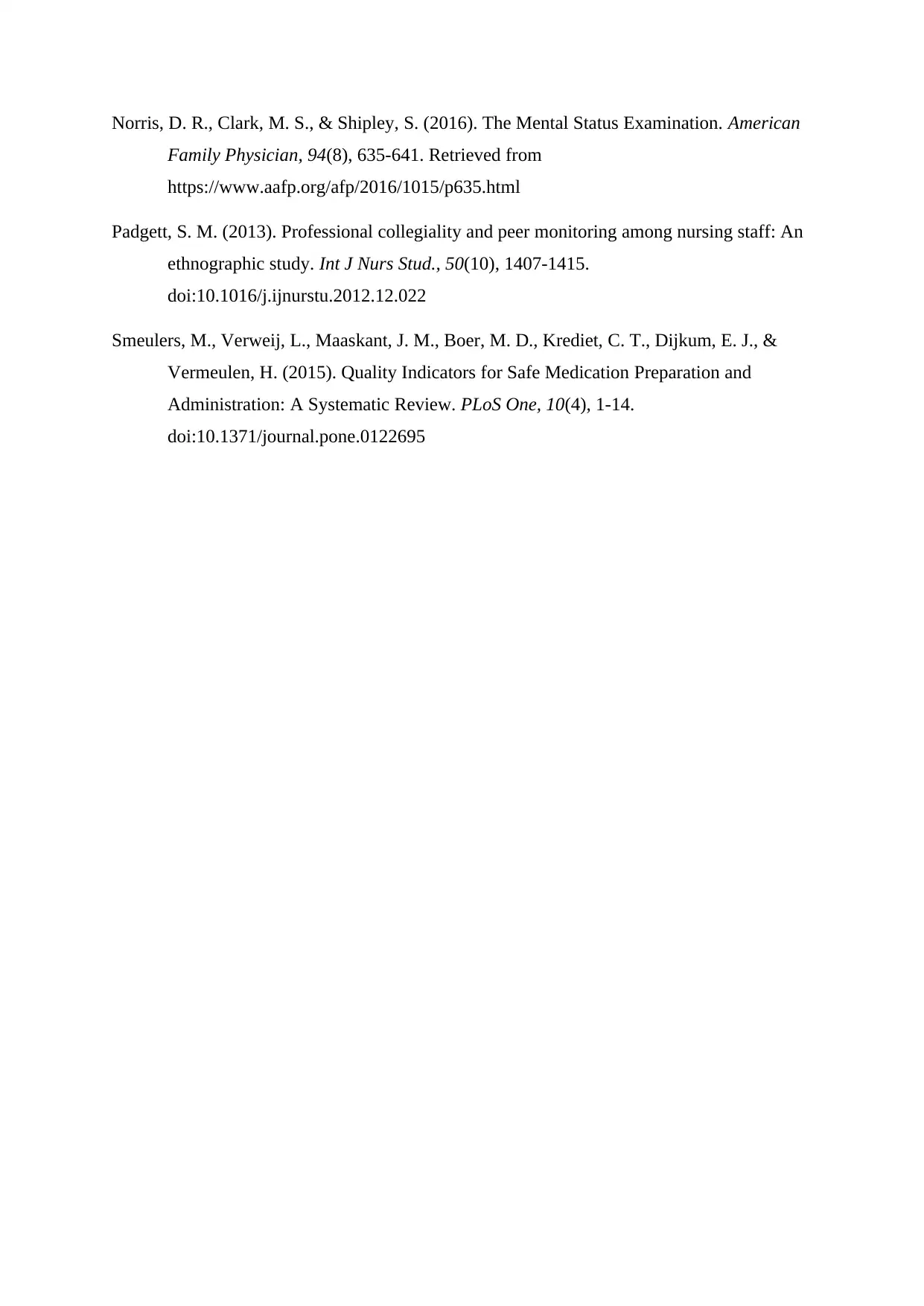
Norris, D. R., Clark, M. S., & Shipley, S. (2016). The Mental Status Examination. American
Family Physician, 94(8), 635-641. Retrieved from
https://www.aafp.org/afp/2016/1015/p635.html
Padgett, S. M. (2013). Professional collegiality and peer monitoring among nursing staff: An
ethnographic study. Int J Nurs Stud., 50(10), 1407-1415.
doi:10.1016/j.ijnurstu.2012.12.022
Smeulers, M., Verweij, L., Maaskant, J. M., Boer, M. D., Krediet, C. T., Dijkum, E. J., &
Vermeulen, H. (2015). Quality Indicators for Safe Medication Preparation and
Administration: A Systematic Review. PLoS One, 10(4), 1-14.
doi:10.1371/journal.pone.0122695
Family Physician, 94(8), 635-641. Retrieved from
https://www.aafp.org/afp/2016/1015/p635.html
Padgett, S. M. (2013). Professional collegiality and peer monitoring among nursing staff: An
ethnographic study. Int J Nurs Stud., 50(10), 1407-1415.
doi:10.1016/j.ijnurstu.2012.12.022
Smeulers, M., Verweij, L., Maaskant, J. M., Boer, M. D., Krediet, C. T., Dijkum, E. J., &
Vermeulen, H. (2015). Quality Indicators for Safe Medication Preparation and
Administration: A Systematic Review. PLoS One, 10(4), 1-14.
doi:10.1371/journal.pone.0122695
1 out of 6
Related Documents
Your All-in-One AI-Powered Toolkit for Academic Success.
+13062052269
info@desklib.com
Available 24*7 on WhatsApp / Email
![[object Object]](/_next/static/media/star-bottom.7253800d.svg)
Unlock your academic potential
© 2024 | Zucol Services PVT LTD | All rights reserved.





